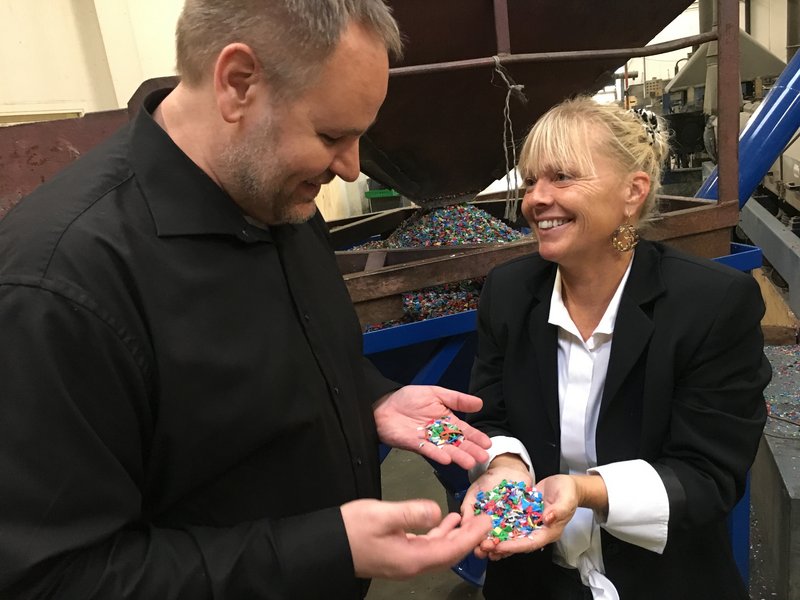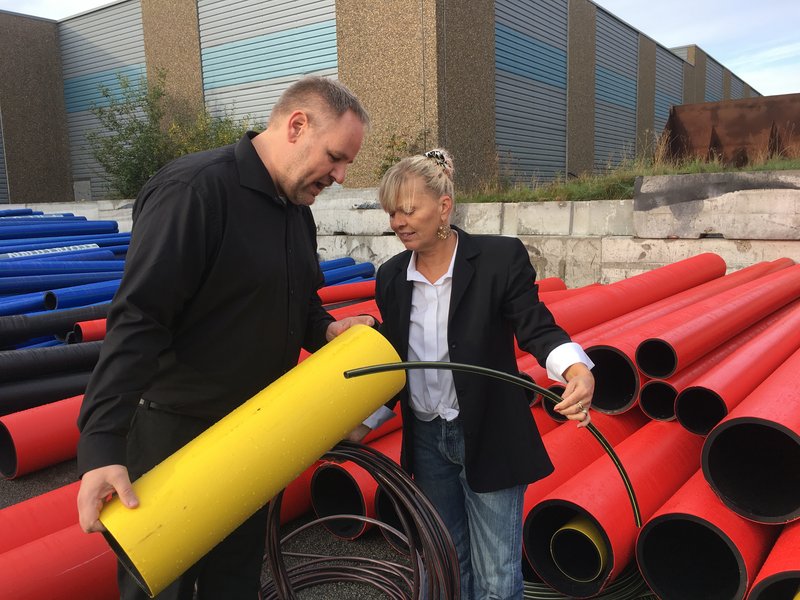New knowledge about old plastics
There is a huge number of different plastic types. This means it is no easy matter to get the rate of plastics recycling to rise. At the Department of Engineering, daily tests on plastics will make it easier for industry to identify the specific type of plastic and produce recycled plastic products in the right quality. Learn more about the research in the podcast below (in Danish).


Researchers at Aarhus University are toiling away to find new knowledge and develop sustainable technology to help the business community and us all to forge a greener future. The Bæredygtig Viden (sustainable knowledge) podcast series is an opportunity to meet researchers who think outside the box and who are working across disciplines and with businesses to find solutions to the world’s major challenges. Jump directly to the podcast here (in Danish).
When is polyester yellowish? How many times can the plastic from a meat tray be recycled before it becomes too degraded? How do you separate the glass from the plastic in glass-fibre-reinforced materials?
Rarely a day goes by without Associate Professor Mogens Hinge from Aarhus University contacting Danish companies that process plastics in one way or another. Such companies may include a food producer using plastics for packaging, a car manufacturer, or a factory processing spent plastic products so that they can be recycled.
"We work with a lot of different businesses. To develop new materials for specific purposes, and to develop solutions to help develop plastics recycling processes," says Associate Professor Mogens Hinge, who is in charge of the Plastics and Polymer Engineering group at the Department of Engineering.
Wavelengths characterise the plastic
In line with national plastics action plans and the requirement that a larger proportion of our plastic waste is to be recycled, there is a growing need for deeper insight into plastics. Not least in the business community.
According to Mogens Hinge, there is a special need for research in two main areas, if more plastics are to be recycled. One area is identifying and separating plastics collected for recycling, while the other is knowledge about the age and condition of the plastics.
"Plastics in rubber wheels and bottles, for example, are chemically very different, and they cannot be mixed together in new production of bottles. For this reason, separating different plastics is absolutely vital in order to achieve a sufficient level of purity, so that the plastic fractions can retain their qualities and become part of a circular process," explains Mogens Hinge.
"Purifying the plastic and identifying which additives have already been added to obtain properties such as flexibility or high-impact resistance is a complex affair. I see this as one of the fundamental reasons why only a small part of the discarded plastic is being reused today," says Associate Professor Hinge.
His research group are therefore busy in their research laboratory looking for solutions to make it easier to grade and purify plastics. Spectroscopy is one of the research methods:
"We shine light of different wavelengths through the plastic, and some of the light remains in the plastic. The spectroscopic analysis tells us which wavelengths the material absorbs and which wavelengths get through. Based on this pattern, we can not only determine whether the plastic type is polystyrene, polyethylene or polypropylene, but we can also identify the type of stabiliser that may have been added," explains Mogens Hinge.
With this knowledge, it is possible to improve the separation processes.
Forced degradation
Crucial knowledge for companies looking to use recycled plastics to produce new products, is about how the different plastics are broken down.
"All the theory says that a plastic material will become increasingly inferior every time it is recycled, but because plastics recycling is a relatively new focus area, there are plastic types about which we don't really know how many times the material can be recycled before it becomes useless structurally," says the associate professor.
Therefore, his group is conducting a number of quality tests. The methods consist of combinations of chemical and physical analyses to determine the temperature effects and flow properties of materials, and thereby their strength after X repeats of a moulding process.
"We simulate industrial processes in the lab, and it may be possible to make do with running just a few grams of material through a process and repeating it 15-20 times to investigate the degradation, without having to use several tonnes of material, as will often be the case in a manufacturing company. This provides valuable knowledge about what we can use the plastics for, under which conditions, and when we need to stop recycling a plastic, if it is to comply with quality requirements," explains Mogens Hinge.
Free access to the research
The Aage Vestergaard Larsen A/S recycling company in Mariager is working with Mogens Hinge and his team to gather specific knowledge about how to utilise recycled plastics in a new way.
"We believe that 3D printing with recycled plastics has a great future ahead, and we want to recycle polypropylene and polyethylene to make filaments for printing," says Gitte Buk Larsen, head of business development, about one of the reasons why Aage Vestergaard Larsen is working with the Department of Engineering.
"The tests required to make 3D printing easier, and with the materials that make the most sense in a circular aspect, are not available today. Our company needs someone like Mogens Hinge and his department to say, ‘Of course, it’s possible’, and that they can then go ahead and provide the necessary knowledge," says Gitte Buk Larsen.
Even though the current collaboration between the recycling company and Plastics and Polymer Engineering is specifically about 3D filaments, Mogens Hinge expects that the project will contribute to more general knowledge that can also benefit other companies. For this reason, he is making most of his research results publicly available via the Open Science Frameworks platform.
"Regardless of whether a company wants to recycle household waste, fishing nets or film, knowledge about the type of plastic, degradation and additives is the underlying challenge, and therefore what we find out will be useful for all plastics processing and recycling companies," says Mogens Hinge.
Contact
Associate Profesor Mogens Hinge,
Department of Engineering – Plastics and Polymer Engineering
Aarhus University
Mail: hinge@au.dk
Mobile: +45 2277 0555
